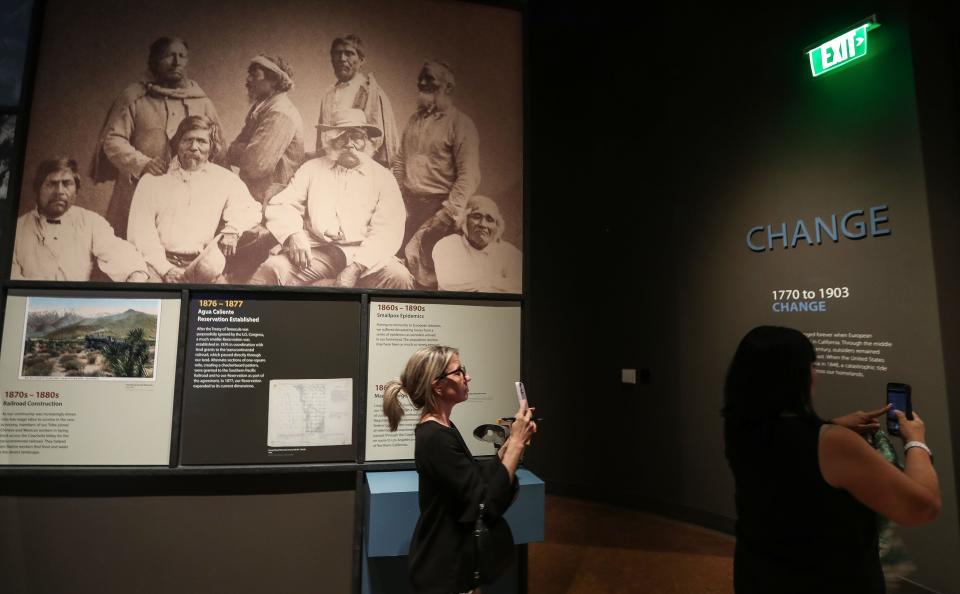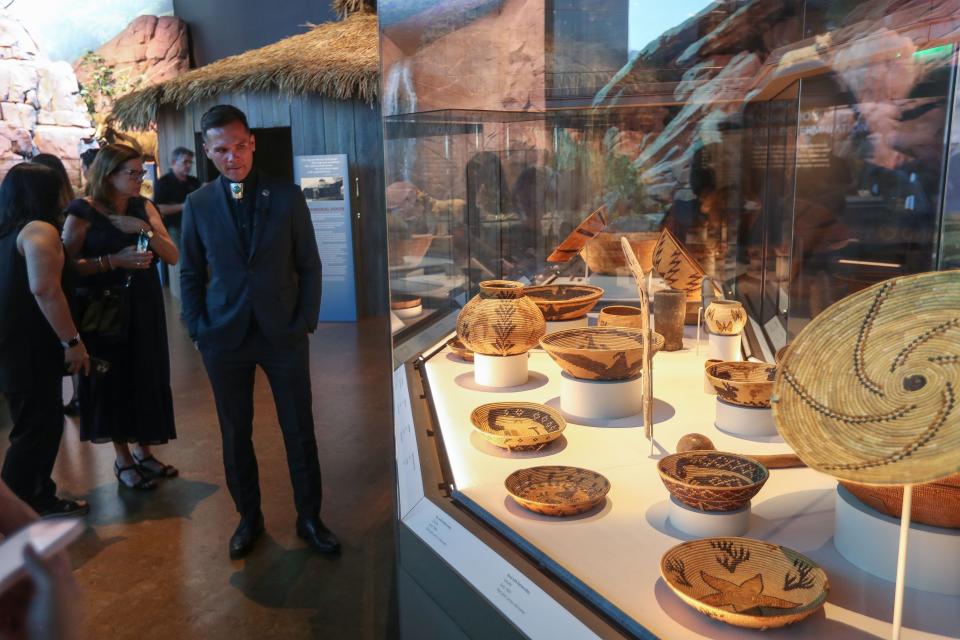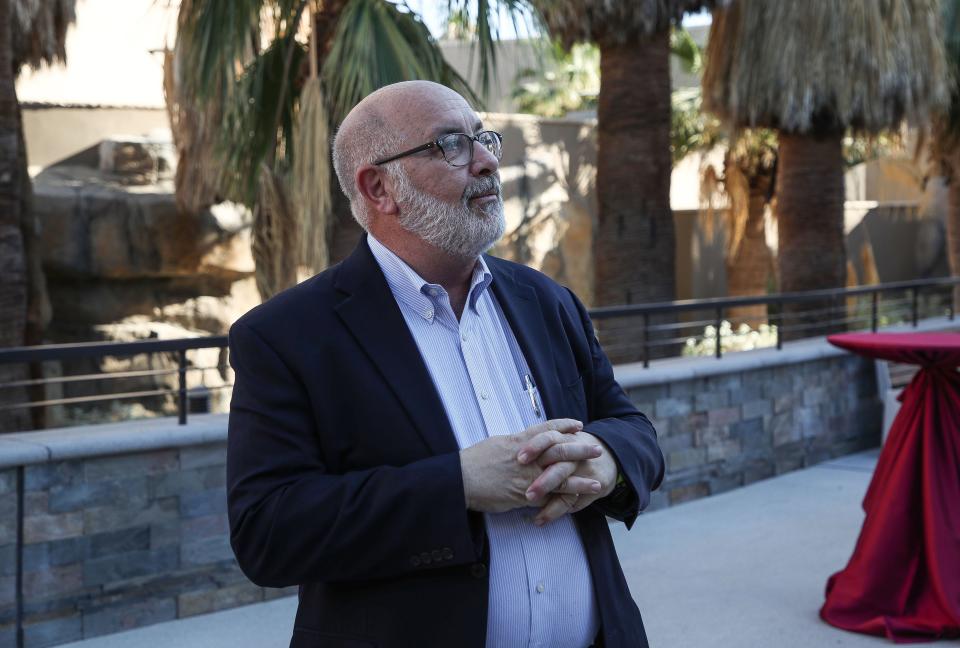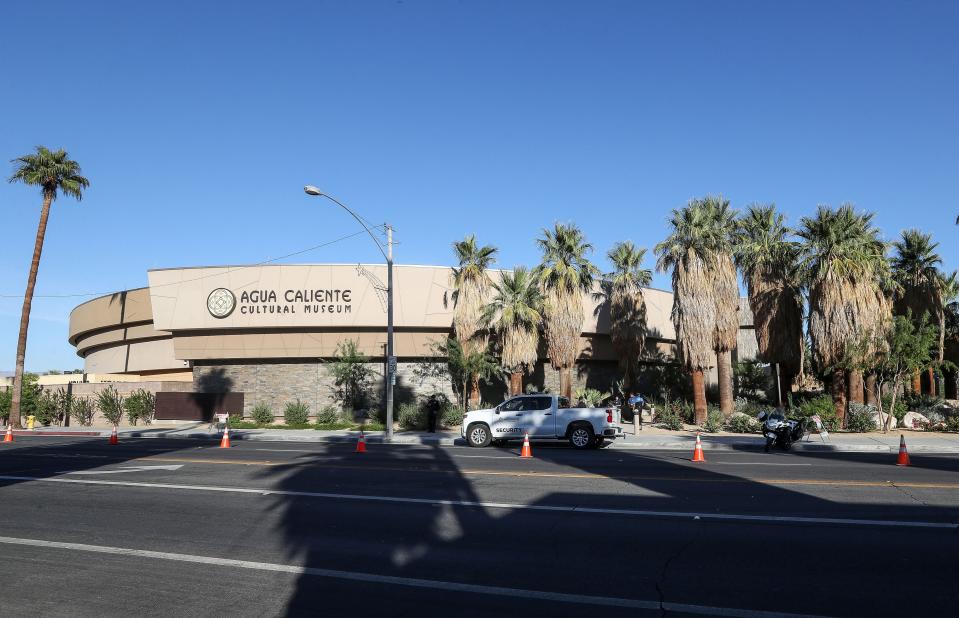Sneak peek at the new Agua Caliente Cultural Plaza and Museum
The wait is finally over: The Agua Caliente Cultural Plaza and Museum will be open to the public Friday in Palm Springs.
The long-awaited project has been discussed for three decades, had its groundbreaking in 2018 and was delayed by the COVID-19 pandemic and a large Indigenous archeological artifact recovery project. But on Friday, the first visitors will step foot inside the 48,000-square-foot museum dedicated to the Agua Caliente Band of Cahuilla Indians.
Inside, five exhibit areas detail the history of the Cahuilla Nation, explore the ancestral lands of the Agua Caliente people and showcase ancient artifacts that were discovered during the excavations for the Cultural Plaza, which includes the museum and The Spa at Séc-he.
The Agua Caliente Cultural Plaza and Museum is located at 140 N. Indian Canyon Drive in downtown Palm Springs. Adjacent is the 40,000-square-foot The Spa at Séc-he, which opened in April.
The Desert Sun got a sneak peek at the museum on Thursday before its doors officially opened to the public.
A journey through history
The Agua Caliente Band of Cahuilla Indians tribal seal greets visitors in the lobby area. Nearby is a map of the Cahuilla Nation, which includes lands occupied by the Agua Caliente Band of Cahuilla Indians and the eight other bands of Cahuilla Indians. The Agua Caliente Band of Cahuilla Indians cares for 31,500 acres within its reservation, which was established in 1876 and expanded in 1877.
The museum has five exhibits that take visitors on a journey through time and teach them more about the tribe. The "Our Home" exhibit starts off the tour with videos of tribe bird singers and dancers and pottery (ollas) on display.

Each space offers something new, and a theater exhibit tells the Agua Caliente Creation and Migration stories using 360-degree projection on the walls and floor. The creation story typically takes hours to tell, but it's been condensed into a 12-minute film told by Francisco Patencio. The immersive video showcases how two twin gods, Mukat and Témayawet, created the Earth, what happened when humans were introduced and how the Cahuilla people eventually settled in the valley.
During various points in the film, the seats will shake to mimic the rumble of thunder. Agua Caliente Chairman Reid D. Milanovich praised the space, saying "this is something that I'm not sure you'll find in another museum."
The next exhibit, titled "Our Land," explores the ancestral lands that the Agua Caliente people call home. Full-scale replicas of the Indian Canyons (Palm, Andreas, Tahquitz and Chino), animals that reside on the lands and the sacred mineral hot spring Séc-he are found in the space. The displays explain which clans originally called the canyons home, and how tribe members utilized native palm trees for food, fiber, building materials and shade.

"If you look closely, everything down to the smallest detail is done," Milanovich said. The projection screen behind the replicas change every few minutes from day and night and display different weather.
The area also includes baskets — Milanovich said the Agua Caliente people are "widely known to be some of the best basket makers in the world" — and a representation of the last ceremonial house. He explained that in the late 1950s, tribal leadership at the time decided to burn down the last remaining ceremonial house. There were many reasons for the decision, he said, but it was mainly tied to new settlers coming into the area and it being a way to assimilate and adapt to the change that was coming.
Similarly, the "Change, Adaptation, Self-Determination" exhibit moves visitors through the tribe's history from 1770 to 1903. The area documents the arrival of Euro-American settlers, how tribe members suffered devastating loses from the smallpox epidemic, work to secure land and water rights and the Palm Springs developmental boom. Photo albums, books and clothing are on display, including a bird singing shirt, bird dancing dress and ribbon dresses made in the 1990s.
Today, three Agua Caliente Casinos in the Coachella Valley have all the poker tables and slot machines gamblers could ever want, but Milanovich was extremely proud to showcase the first slot machine that was installed in 1995.

“We have come a long way since Blue Light,” he said, referring to the slot. And even though the tribe's gaming facilities are much larger than their first one, which looked like a tented space, Milanovich said the tribe is still so proud of its beginnings.
The final exhibit, "Into the Future," actually steps back into the past by about 8,000 years. It showcases some of the artifacts that were discovered during the excavations for the Agua Caliente Cultural Plaza, such as manos, metates and projectile points used for hunting and defense.
The Agua Caliente Cultural Museum will also have a rotating Changing Gallery to showcase traditional and contemporary Native American art. Currently on display is "For a Love of His People: The Photography of Horace Poolaw," an American Indian photographer who documented Indian subjects. The gallery will be on display through December 2024.
Architecture pays homage to tribal history

Principal architect Scott Celella, of JCJ Architecture, led the design project for the museum and utilized several Agua Caliente influences throughout the creation process.
He explained that the Oasis Trail, located between the two buildings, includes native plants, rock formations and water features inspired by those in the Indian Canyons and Tahquitz Canyon.
The slate stone tile that is seen on the exterior of the museum is inspired by a "huge outcropping" that is prominent in Andreas Canyon, he said. It has yellow and purple tones in the area, which are seen on the building today. Additionally, he wanted the building to "fit in with the town" and architecture around the area. From above, the building has a curved shape.
If you go
What: The Agua Caliente Cultural Museum
When: Open 10 a.m. to 5 p.m. Tuesdays through Sundays (and closed on Mondays)
Where: 140 N. Indian Canyon Drive, Palm Springs
Cost: $10 for adults 18 and older, $5 for children 6-17, free for children under 6, $5 for seniors 65 and older, $8 for Coachella Valley residents with valid ID, and free for Native American tribal members, active duty U.S. military personnel and U.S. military veterans
More info: visit www.accmuseum.org
Ema Sasic covers entertainment and health in the Coachella Valley. Reach her at ema.sasic@desertsun.com or on Twitter @ema_sasic.
This article originally appeared on Palm Springs Desert Sun: Agua Caliente Cultural Plaza and Museum opens Friday in Palm Springs

